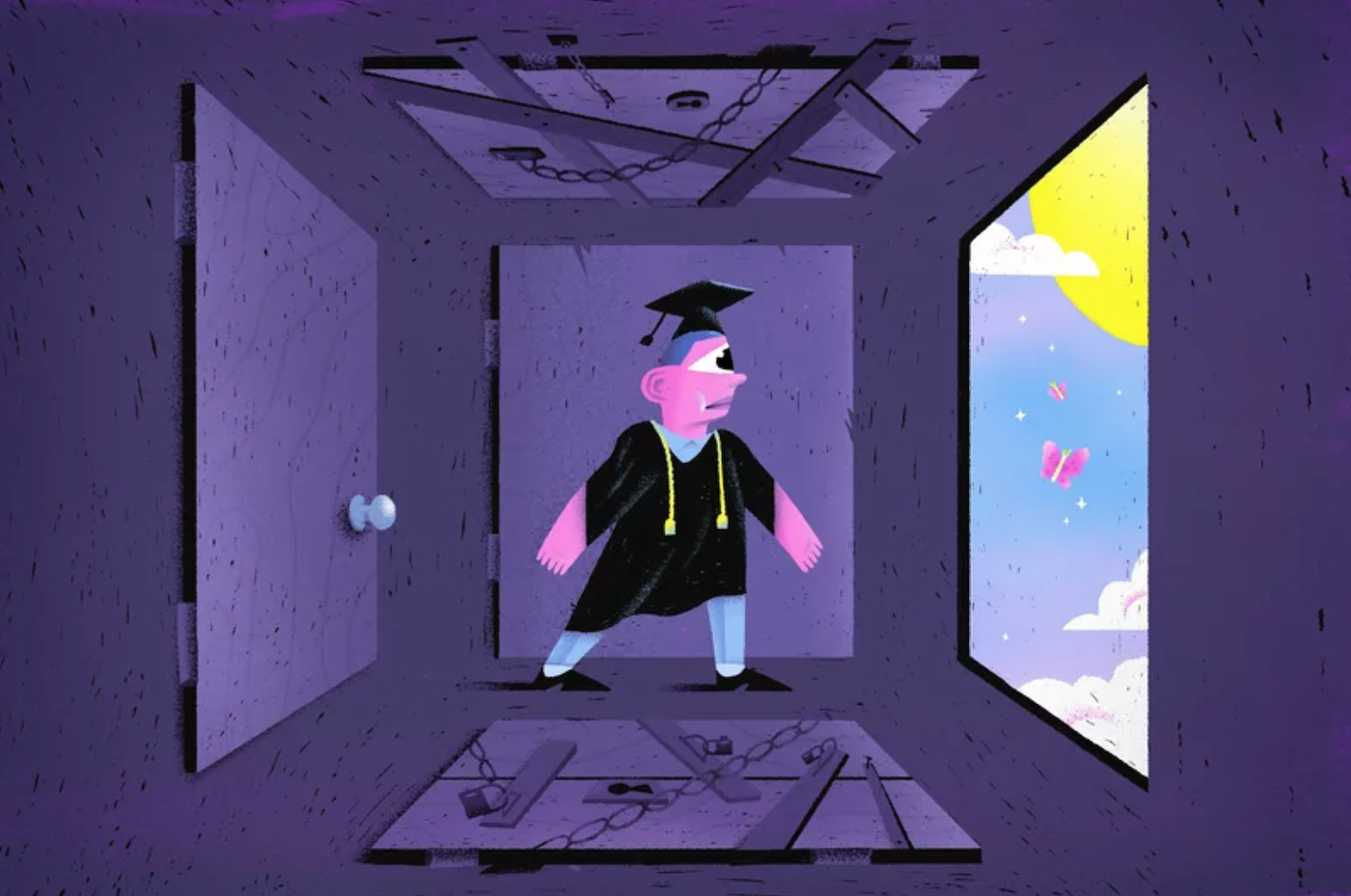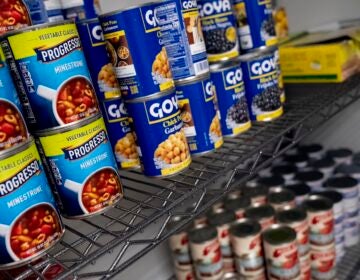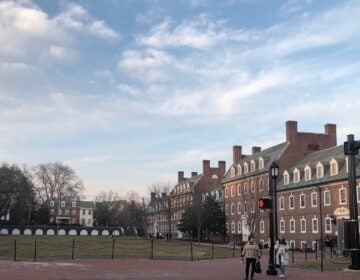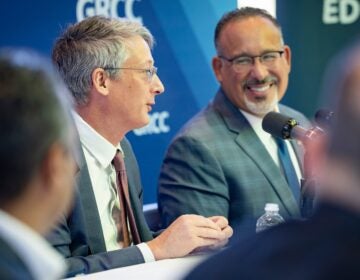Millions could benefit from a new way out of student loan default

(Andrew Haener for NPR)
Juan Carlos Moreno was in trouble. A public high school teacher in Alabama, he lost his car earlier this year to a catastrophic engine problem, and trying to replace it was proving difficult.
That’s because Moreno’s federal student loans had been in default for years, his credit in tatters. Even renting an apartment had been tough.
“My wife and I had separated, so I had to get an apartment on my own,” Moreno remembers. “And I had to have a cosigner to get this $500 a month, little bitty studio apartment.”
Moreno is not alone. The federal student loan system is in the teeth of a grinding crisis, with nearly 7 million borrowers dogged by default and its consequences, according to data provided by the U.S. Department of Education. In the past decade, the number of federal direct loan borrowers in default has more than doubled.
Now, as borrowers slowly return to repayment after the pandemic pause, the Biden administration has unveiled a plan to turn this tide of defaults and help borrowers back into good standing.
It’s called Fresh Start. But the clock is ticking, as the Education Department has given itself the next year to reach millions of the system’s most vulnerable borrowers.
Who defaults and why
The road to default begins with delinquency: one missed loan payment, then another. And another. After 270 days without a payment, a federal student loan plunges into default.
Borrowers who default often share a common story. According to the Institute for College Access & Success, more than half have less than $10,000 in student debt, and nearly half attended college but did not complete a degree, which means they never benefit from the earnings bump that traditionally justifies taking out student loans.
Defaults also tend to exacerbate long-standing wage, wealth and opportunity gaps. According to The Pew Charitable Trusts, 29% of white borrowers default on their federal student loans compared to 40% of Hispanic borrowers and 50% of Black borrowers.
“Black borrowers in particular have extremely high default rates because they have fewer financial resources to pay for college,” says Victoria Jackson, with The Education Trust, a nonprofit that advocates for equity in education.
The common denominator, though, is poverty. Americans with incomes below twice the federal poverty line account for 65% of defaulted borrowers according to the Institute for College Access & Success.
Juan Carlos Moreno remembers the impossible math of his own default in 2015.
“I have three children. We need to have four walls,” he remembers thinking. “We need to have food. We need to have health care.” But after paying for those priorities, he says, there simply wasn’t enough money left over to pay his monthly federal student loan bill.
Moreno didn’t want to default on his student loans, but his family was in crisis. After the Great Recession, they lost their home and, in late 2011, filed for bankruptcy.
“It may sound irresponsible, but I had heard other people saying the same thing: ‘I just can’t do it, so I’m not doing it.’ And it was terrifying to [default]. But I did.”
The consequences of default
Moreno stopped paying his federal loans, and eventually they fell into default.
Nearly 7 million other federal student loan borrowers have their own stories of struggle.
“That’s not millions of people who are deadbeats or, you know, tax cheats,” says Moreno. “I think most of them are just like me: Hardworking people who had no other choice.”
The problem with defaulting on federal student loans is, while it offers immediate relief from one financial burden, it brings with it a battery of other, punishing consequences.
“Consequences that ripple throughout people’s lives,” says Jackson of The Education Trust. “[Borrowers] can have their wages garnished. If they’re receiving Social Security, that can be garnished. Any tax refunds, like the EITC, which is incredibly important for low-income people, can be garnished.”
Though Moreno never had his wages garnished, he knew it could happen.
“Almost every month, coming around to payday time, I was so worried I was going to see the wrong figure on my check, on my direct deposit,” Moreno says. “It was very scary.”
He lived with that fear for years, until recently, when the impossible math of repaying his loans seemed suddenly … possible, because of this new program promising a reset.
How Fresh Start offers a way out
Right now, borrowers with federal student loans in default are already feeling relief without having to do a thing. As part of Fresh Start, the Biden administration has extended the pandemic-driven pause on collections on defaulted loans until at least September 2024. Wages and tax refunds aren’t being garnished. Social Security payments aren’t being withheld. The harassing collections calls… they’ve stopped too.
Many borrowers’ credit reports have also improved, with defaulted federal loans now reported as “current” instead of “in collections.”
The problem is this is a temporary reprieve. If borrowers in default want to keep these benefits, they have through September 2024 to opt into Fresh Start – the simplest path yet out of default.
The process takes about 10 minutes to initiate. Borrowers need only let the U.S. Education Department know they would like to use Fresh Start. That will then trigger the shifting of their loans back to a traditional loan servicer.
After enrolling, borrowers will be able to qualify, once again, for federal financial aid – an important benefit to help the nearly half who attended college but did not complete a degree.
Perhaps most importantly, in the past, borrowers emerging from default could not immediately qualify for the most flexible, income-driven repayment plan, but the Biden administration has changed that too. When opting into Fresh Start, many borrowers can now enroll in the newest, most generous plan, known as SAVE, which offers lower payments and loan forgiveness after a set number of years.
For many low-income borrowers, SAVE could be a game-changer. According to newly released federal data, 2.9 million borrowers who are enrolled in SAVE earned incomes low enough that they qualified for a $0 monthly payment. For these borrowers, being in good standing, and even earning their way toward loan forgiveness, costs less than being in default.
That’s why, a few weeks ago, Juan Carlos Moreno went online to enroll in Fresh Start.
Getting the word out to defaulted borrowers won’t be easy
“It was easy!” Moreno wrote in an email to NPR after finishing the online application.
According to the Education Department, more than 300,000 borrowers have already opted into the program, though that’s a small fraction of the borrowers languishing in default.
“I’m very happy that those folks have been able to take advantage of this opportunity,” says Biden’s under secretary of education, James Kvaal. “But obviously, we have a long way to go.”
Experts warn, historically, borrowers in default have been the hardest to reach. Many do not have updated contact information on file and may have little interest in returning to repayment.
“A really big piece here is just awareness, just getting the word out,” says Brian Denten, with The Pew Charitable Trusts’ Student Loan Initiative. “Based on past research, we’ve seen that borrowers who end up in default… just weren’t aware of income-driven repayment’s existence, or weren’t aware of who to call to learn more about things.”
To that end, Kvaal says the department is working with grassroots organizations, including the NAACP and UnidosUS. “These are groups that have strong relationships with borrowers… and credibility in helping them make decisions about their student loans.“
Outreach won’t be the only challenge. According to a 2016 report from the Consumer Financial Protection Bureau, 1 in 3 borrowers who emerge from default “will re-default within two years due to servicing and program failures.”
Juan Carlos Moreno is now waiting to hear from his new loan servicer. While he doesn’t yet know what his monthly payment will be, he knows it will be more affordable than the options available to him when he first plunged into default. Not only that: By opting into Fresh Start, he’ll receive more than three years of payment credit from the pandemic pause – time he can apply, as a public school teacher, toward the 10-year requirement to qualify for Public Service Loan Forgiveness.
With his credit reflecting his loans back in repayment, he’s also been able to replace his car.
“The change that I felt that day,” Moreno says, holding back tears, of the day he heard about Fresh Start, “I felt like I was lifting out of my chair. The idea that I could walk around every day without this oppressive, heavy feeling of shame on me all the time, every day, I guess I thought it was never going to happen.”
Edited by: Nicole Cohen
Visual design and development by: LA Johnson
Audio story produced by: Lauren Hodges
Audio story edited by: Nicole Cohen and William Troop
9(MDAzMzI1ODY3MDEyMzkzOTE3NjIxNDg3MQ001))




